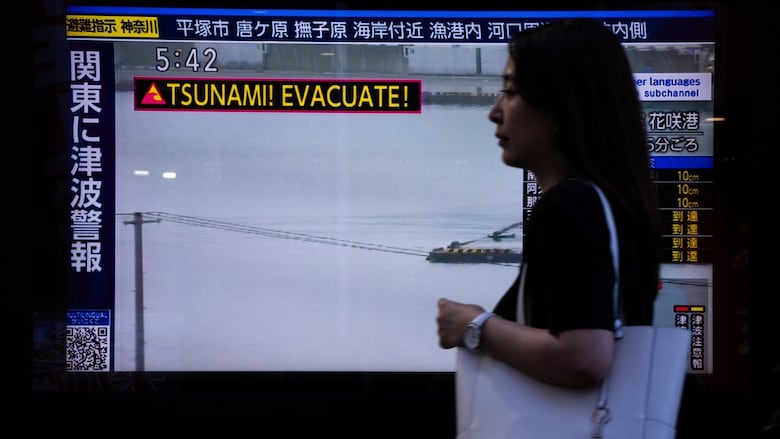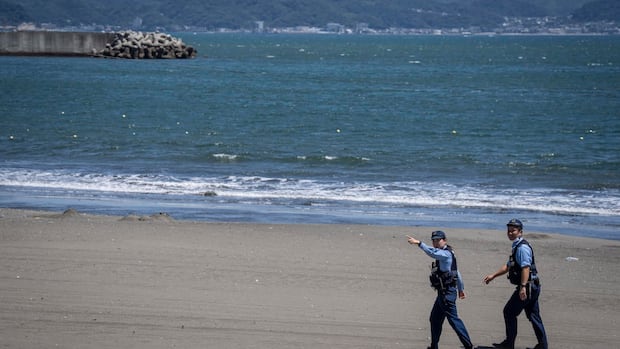Japan, Hawaii and Russia downgrade tsunami warnings after powerful earthquake
No widespread damage so far where strong ocean waves have already washed ashore

One of the strongest earthquakes ever recorded struck off Russia's sparsely populated Far East early Wednesday, sending tsunami waves into Japan, Hawaii and the U.S. West Coast. Several people were injured, but none gravely, and no major damage has been reported so far.
Authorities warned the risk from the 8.8 magnitude quake could last for hours, and millions of people potentially in the path of the waves were initially told to move away from the shore or seek high ground.
The worst appeared to have passed with warnings lifted or downgraded for many areas, including the U.S., Japan and Russia. But along South America's Pacific Coast, new warnings were forcing evacuations in Chile and Colombia.
In the immediate aftermath of the quake off Russia's Kamchatka peninsula, residents fled inland as ports flooded, and several were injured while rushing to leave buildings.
People flocked to evacuation centres in affected areas of Japan, with memories fresh of the 2011 earthquake and tsunami that caused reactor meltdowns at a nuclear power plant. No abnormalities in operations at Japan's nuclear plants were reported Wednesday.
Russian authorities said several people were injured, but said all were in stable condition, though they gave few details. In Japan, at least one person was injured.
A tsunami height of three to four metres was recorded in Kamchatka, 60 centimetres on Japan's northern island of Hokkaido, while tsunami waves about 60 to 152 centimetres high reached San Francisco early Wednesday, officials said.
Much of the West Coast, spanning California, Oregon, Washington and British Columbia, were under a tsunami advisory.
Hawaii downgrades to tsunami advisory
Hawaii was still under a tsunami advisory as Wednesday began, but evacuation orders on the Big Island and Oahu, the most populated island, had been lifted.
An advisory means there is the potential for strong currents and dangerous waves, as well as flooding on beaches or in harbours.
"As you return home, still stay off the beach and stay out of the water," said James Barros, administrator of the Hawaii Emergency Management Agency.
The impact of the tsunami could last for hours or perhaps more than a day, said Dave Snider, tsunami warning co-ordinator with the National Tsunami Warning Centre in Alaska.
"A tsunami is not just one wave," he said. "It's a series of powerful waves over a long period of time. Tsunamis cross the ocean at hundreds of miles an hour — as fast as a jet airplane — in deep water. But when they get close to the shore, they slow down and start to pile up. And that's where that inundation problem becomes a little bit more possible there."
Cars jammed streets and highways in Honolulu as the tsunami alerts coincided with the Tuesday afternoon rush-hour. Warning sirens blared as people moved to higher ground. Hawaii schools cancelled after-school and evening activities, and tourists in evacuation zones were asked to contact their hotel if they can't get to an airport.
Hawaii Gov. Josh Green earlier said Black Hawk helicopters were activated and high-water vehicles ready to go in case authorities needed to rescue people.
The Oregon Department of Emergency Management said on Facebook that small tsunami waves were expected along the coast. It urged people to stay away from beaches, harbours and marinas and to remain in a safe location away from the coast until the advisory is lifted.
"This is not a major tsunami, but dangerous currents and strong waves may pose a risk to those near the water," the department said.
Small tsunamis hit overnight
Waves under 30 centimetres above tide levels were observed in the Alaskan communities of Amchitka and Adak, said Alaska's National Tsunami Warning Centre co-ordinator Dave Snider.
Tsunami waves washed up to the shoreline on Japan's Hokkaido in the north and Ibaraki and Chiba, just east of Tokyo, in footage aired on Japan's NHK public television. A tsunami of 50 centimetres was also detected at the Ishinomaki port in northern Japan, according to the Japan Meteorological Agency (JMA).
That was the highest measurement so far among several locations around northern Japan. But higher waves were still arriving on Wednesday, said JMA earthquake and tsunami response official Shiji Kiyomoto.
The Russian areas nearest the quake's epicentre on the Kamchatka Peninsula reported damage from the earthquake and evacuations from the tsunami, but no serious injuries.
The first tsunami wave hit the coastal area of Severo-Kurilsk, the main settlement on Russia's Kuril Islands in the Pacific, according to the local governor, Valery Limarenko. He said residents were safe and staying on high ground until the threat of a repeat wave was gone.
Early Wednesday, the U.S. National Oceanic and Atmospheric Administration updated its tsunami bulletin to include regional observations, and for B.C., that included an "observed maximum tsunami height" of 27 centimetres at Winter Harbour, and 21 centimetres at Tofino.
The quake at 8:25 a.m. Japan time on Wednesday had a preliminary magnitude of 8.0, Japan and U.S. seismologists said. The U.S. Geological Survey later updated its measurement to 8.8 magnitude and the USGS said the quake occurred at a depth of 20.7 kilometres.
U.S. Secretary of Homeland Security Kristi Noem said the threat of a major tsunami hitting the United States "has passed completely."
Earthquake causes damage in Russia
The quake was about 119 kilometres away from the Russian city of Petropavlovsk-Kamchatsky on the Kamchatka Peninsula, which has a population of 180,000.
Russia's Tass news agency said people in Petropavlovsk-Kamchatsky ran out into the street without shoes or outerwear. Cabinets toppled inside homes, mirrors were broken, cars swayed in the street and balconies on buildings shook noticeably.
Tass also reported power outages and mobile phone service failures, and quoted a local Russian official as saying residents on Sakhalin Island were being evacuated and emergency services were working at full capacity.
The quake was the strongest to hit this area in the Kamchatka Peninsula since 1952, according to the local branch of the Geophysical Survey of the Russian Academy of Sciences.
They said that while the situation "was under control" there are risks of aftershocks, which could last for up to a month and warned against visiting certain coastal areas.
Earlier in July, five powerful quakes — the largest with a magnitude of 7.4 — struck in the sea near Kamchatka. There was also a 7.3-magnitude earthquake earlier this month on Alaska's southern coast.
The most recent earthquake appeared to be the strongest anywhere in the world since the March 2011 earthquake off northeast Japan that was 9.0 magnitude and caused a massive tsunami that set off meltdowns at a nuclear power plant. Only a few stronger earthquakes have ever been measured around the world.
With files from The Associated Press



